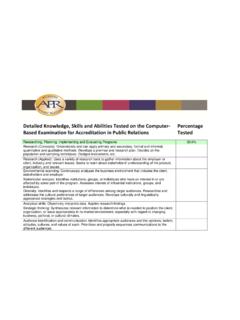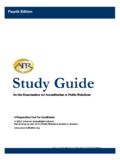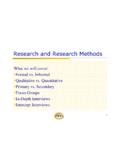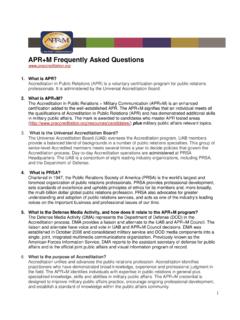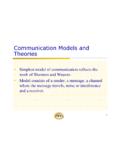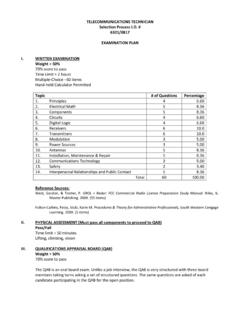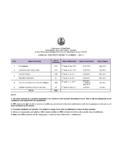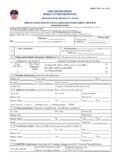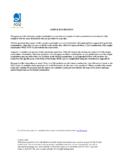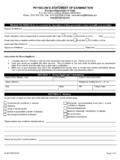Transcription of Detailed Knowledge, Skills and Abilities Tested on the ...
1 Detailed knowledge , Skills and Abilities Tested on the Computer- based Examination for Accreditation in Public Relations (effective Percentage January 2016) Tested Objective 1 Researching, Planning, Implementing and Evaluating Programs 33%. Research (Concepts): Understands and can apply primary and secondary, formal and informal, quantitative and qualitative methods. Decides on the population and sampling techniques. Understands instrument design. Develops a premise and research plan. Research (Applications): Uses a variety of research tools to gather information about the employer or client, industry and relevant issues.
2 Investigates stakeholders' understanding of the product, organization and issues. Applies research findings. Analytical Skills : Continuously analyzes the business environment that includes the client, stakeholders and employer. Objectively interprets data. Strategic thinking: Synthesizes relevant information to determine what is needed to position the client, organization, or issue appropriately in its market/environment, especially with regard to changing business, political, or cultural climates. Planning: Sets goals and objectives based on research findings. Distinguishes among goals, objectives, strategies and tactics.
3 Distinguishes organizational/operational goals and strategies from communication goals and strategies. Aligns project goals with organizational mission and goals. Audience identification: Differentiates among publics, markets, audiences and stakeholders. Identifies appropriate audiences and the opinions, beliefs, attitudes, cultures, and values of each. Assesses interests of influential institutions, groups and individuals. Identifies appropriate communication channels/vehicles for reaching target audiences. Identifies communities formed through technologies. Understands varying needs and priorities of individual constituent groups ( , investors, governmental agencies, unions, consumers).
4 Diversity: Identifies and respects a range of differences among target audiences. Researches and addresses the cultural preferences and/or needs and barriers to communication of target audiences. Develops culturally and linguistically appropriate strategies and tactics. Implementation: Understands sequence of events. Develops timelines and budget. Assigns responsibilities. Executes planned strategies and tactics. Evaluation of programs: Determines if goals and objectives of public relations program were met and the extent to which the results or outcomes of public relations programs have been accomplished.
5 Uses evaluation results for future planning. Objective 2 Applying Ethics and Law 13%. Integrity: Conducts professional activities in a lawful and principled manner. Functions as the conscience of the organization. Ethical behavior: Understands and adheres to commonly accepted standards for professional behavior. Recognizes ethical dilemmas. Acts to remedy unethical acts. First Amendment issues: Understands First Amendment as a foundational principle for public relations. Distinguishes between political and corporate speech. Articulates conditions for libel and defenses thereof.
6 Understands impact of digital record on status as public and private figure. Privacy issues: Understands federal law regarding privacy ( HIPAA, FERPA, DPPA), identity protection, ethical implications and digital record. Effectively advises organization on strategic adoption and effective use of technology for listening to, communicating with and engaging priority publics. Other legal issues: Upholds applicable federal laws regarding disclosure, copyright, trademarks, fair use. Objective 3 Managing Issues and Crisis Communications 13%. Issues and risk management: Identifies potential or emerging issues that may impact the organization.
7 Identifies potential risks to the organization or client. Analyzes probability and potential impact of risk. Ensures organization develops appropriate response plans. Designs and deploys a strategic public relations response. Crisis management: Understands the roles and responsibilities of public relations at the pre- crisis, crisis, and post-crisis phases. Communicates the implications of each of these phases and understands the messaging needs of each. Looks beyond current organizational mindset. Counsel to management: Understands the importance of providing counsel to the management team or client regarding issues, risks and crises.
8 Looks beyond the current organizational mindset Considers and accommodates all views on an issue or crisis. Factors views into communication strategy. Objective 4 Understanding Communication Models, Theories and History of the Profession 8%. Communication/public relations models and theories: Demonstrates familiarity with social science theories and research that guide planning, prioritizing audiences, developing messages, selecting spokespeople, establishing credibility and trust. Barriers to communication: Understands how messages and messengers are interpreted by different audiences.
9 Understands barriers that prevent changes to knowledge , attitude and behavior. Understands how semantics, cultural norms, timing, context and related factors impact the practice. knowledge of the field: Defines public relations and differentiates among related concepts ( publicity, advertising, marketing, press agentry, public affairs, lobbying, investor relations, social networking, and branding). Identifies key figures who influenced the field and major trends in the development of public relations as it is practiced today. Objective 5 Leading the Public Relations Function 18%.
10 Business literacy: Understands and explains how employers/clients generate revenue and how their operations are conducted. Identifies relevant business drivers and how they impact the business. Understands how the public relations function contributes to the financial success of the organization. Resource management: Takes into account human, financial and organizational resources. Prepares, justifies and controls budgets for departments, programs, clients or agencies. Understands what information needs to be collected, evaluated, disseminated, and retained. Is able to obtain information using innovative methods and appropriately store it, so that it can be retrieved easily for future use.
